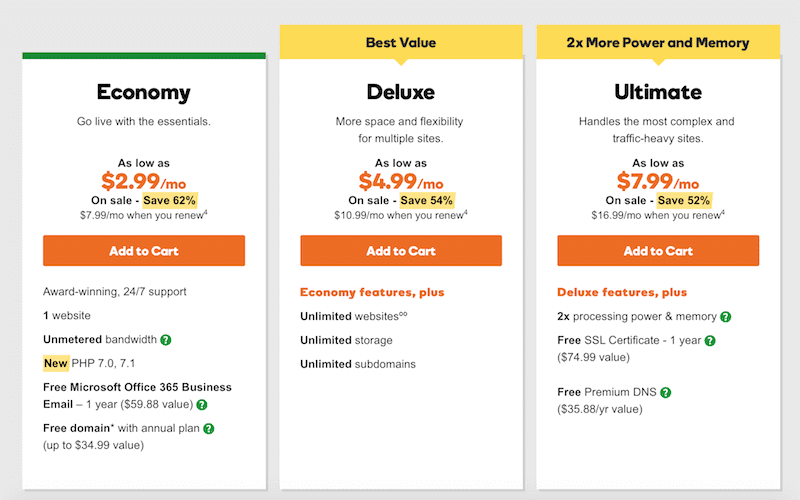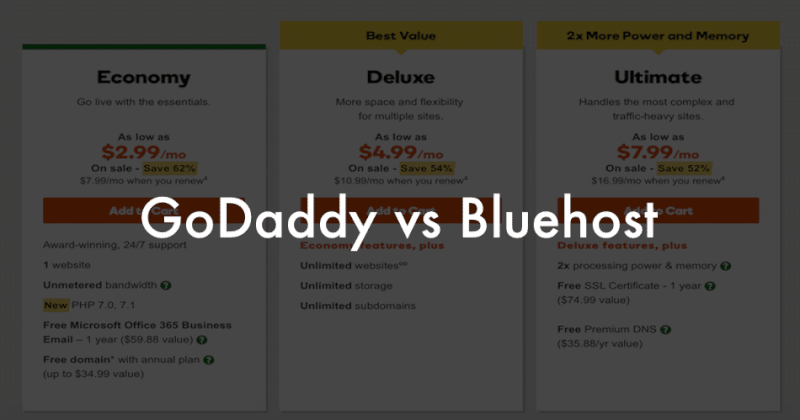In today’s post on GoDaddy vs Bluehost, we’ll compare these two popular web hosting companies and find which one is better for your website or blog. It does not matter if you have a small size blog or you want to host a high-traffic website; you need to focus on security, prices, features, and customer support, without neglecting additional features like server speed and renewal costs.
These two are arguably two of the biggest web hosts in the world today. Their services are known the world over, and they are constantly fighting for market dominance in certain key areas.
GoDaddy vs. Bluehost comparison
GoDaddy
GoDaddy comes off as more of a domain hosting company. Bluehost, on the other hand, stands out as one of the best-positioned WordPress hosting services.
Despite these stark differences, various things do bring these hosting companies together. It is these things that they share in common that make it so hard to choose between them.
When you land on their websites, the first thing that you notice is that these companies are positioned very differently. GoDaddy leans more toward domain selling and reselling while Bluehost leans towards web hosting.
Despite this apparent bias towards some services, both of these web hosts offer shared hosting, VPS hosting, WordPress hosting, and dedicated hosting.
Both of these web hosts offer the three-tier plan that customers have come to expect from web hosting companies.
Bluehost
At the lower end, Bluehost offers shared hosting that starts at $3.95 per month, a price that goes up steeply to $7.99 per month when the promotional period lapses.

On the mid-level tier, they offer web hosting that starts at $5.95 per month that goes up to $10.99 per month. The higher-end plan also starts at $5.95 per month but goes up to $14.99 per month instead.
Well, seeing that the initial price is the same, lots of customers would ask themselves what the differences are between these two upper tiers.
One of the major differences is that with the high-end tie, you get domain privacy and regular site backups while on the middle-tier, you do not.
In addition, you get over $80 worth of extras that range from advertising credits to other benefits per year. It is important to note that all hosting plans from Bluehost come with a free domain name which is a huge plus, especially for new customers.
When it comes to GoDaddy, you also get three different levels:
- The lower tier, the Economy plan, starts at $3.99 per month and is renewable at $7.99.
- The mid-tier plan, the Deluxe Plan, starts at $4.99 per month and is renewable at $10.99 per month.
- The Ultimate Plan, designed to handle the most complex websites, starts at $7.99 per month and is renewable at $16.99 per month.

As with Bluehost above, this high-end tier does come with some additional benefits. For example, you get twice the processing power and memory you get on the other two plans, Premium DNS and a 1-year SSL certificate for free. The SSL certificate is vital if you are looking to run a secure website like an e-commerce store.
GoDaddy vs. Bluehost on domain names
Despite the fact that Bluehost and GoDaddy both offer domain names as part of all their Linux-shared hosting plans, only GoDaddy positions itself as a domain-selling hub. GoDaddy works very closely with the world’s domain authority.
Doing this allows them exclusive access to most domain name extensions which places as at a prime position to sell and resell domain names. In this category, we can safely say that GoDaddy knocks Bluehost out of the park.
GoDaddy has the largest domain marketplace with millions of names, so, you can use them to find a good expired domain for your Blog if you want. Additionally, GoDaddy offers an advanced DNS management tool with all the settings and configurations you need.
Additional features
Both GoDaddy and Bluehost have lots of additional features to offer. Although most of these additional features and bonuses become available for purchasing a hosting account, they are worth mentioning.
Bluehost offers dedicated WordPress and Woocommerce hosting. These are arguably the biggest Content Management Systems and e-commerce platforms in the world, respectively.
When you sign up to Bluehost for a WordPress or Woocommerce hosting account, you get 24/7 dedicated support. In addition, they provide software that allows for easy installation of Woocommerce and WordPress.
The software lets you have a running website and a fully functioning e-commerce store in a matter of minutes.
GoDaddy vs. Bluehost on security
For both of these accounts, they do offer top-of-the-line security to ensure your payments are always safe. When it comes to shared hosting, the extras you receive depend on the hosting account you sign up for.
These extras include Site backups, a dedicated specialist, and domain privacy. Bluehost has an ace up their sleeve though. In addition to the three primary accounts mentioned above, they have a fourth one, The Go Pro Account.
This account comes with a high-performance server, a Dedicated IP, an SSL Certificate, Domain Privacy, and of course Site Backup Pro.
Those looking to make some money online can do so with Bluehost. They have robust hosting resellers and affiliate programs that pay on time and that are very successful.
Although Bluehost packs a lot of extra stuff with their hosting accounts, GoDaddy does not slack either. With all their accounts, they promise 24/7 security monitoring for your website and also, DDoS protection, an easy-to-use control panel, and 1-click installation and setup for the GoDaddy registered domains.
They also offer something that is fascinating, a 1-click purchase feature for additional resources.
Some users find the resources for the tier they are on inadequate. When they try to upgrade, they find the next tier would be too much for their needs.
Well, GoDaddy lets you buy exactly what you need so that you do not have to worry if you are on the right tier. In addition, they allow you to upgrade to higher tiers whenever you so wish.
When you visit the GoDaddy website, you will notice that they have other services on offer too. For example, they have online marketing as well as email hosting plans. If these are things you need for yourself or your business, you could get in touch with them for more information.
GoDaddy vs Bluehost: Which is better?
The comparison between GoDaddy and Bluehost, purely in terms of hosting only, is too close to call. That said, though, GoDaddy manages to pull ahead slightly because of the additional features they offer on sign-up. Despite this, you will not go wrong no matter which of these two web hosting companies you choose.
